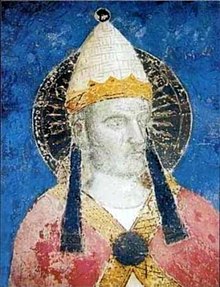Gregory X | |
|---|---|
| Bishop of Rome | |
 Fresco of Gregory X by Buonamico Buffalmacco (c. 1330) | |
| Church | Catholic Church |
| Papacy began | 1 September 1271 |
| Papacy ended | 10 January 1276 |
| Predecessor | Clement IV |
| Successor | Innocent V |
| Previous post(s) |
|
| Orders | |
| Ordination | 19 March 1272 |
| Consecration | 27 March 1272 by John of Toledo |
| Personal details | |
| Born | Teobaldo Visconti c. 1210 |
| Died | 10 January 1276 (aged 65–66) Arezzo, Holy Roman Empire |
| Coat of arms |  |
| Sainthood | |
| Feast day | 10 January |
| Venerated in | Catholic Church |
| Title as Saint | Blessed |
| Beatified | 8 July 1713 Rome, Papal States by Pope Clement XI |
| Attributes | |
| Patronage |
|
| Other popes named Gregory | |
Ordination history of Pope Gregory X | |||||||||||||||||||||||||||
|---|---|---|---|---|---|---|---|---|---|---|---|---|---|---|---|---|---|---|---|---|---|---|---|---|---|---|---|
| |||||||||||||||||||||||||||
| |||||||||||||||||||||||||||
Pope Gregory X (Latin: Gregorius X; c. 1210 – 10 January 1276), born Teobaldo Visconti, was head of the Catholic Church and ruler of the Papal States from 1 September 1271 to his death and was a member of the Secular Franciscan Order. He was elected at the conclusion of a papal election that ran from 1268 to 1271, the longest papal election in the history of the Catholic Church.
He convened the Second Council of Lyon and also made new regulations in regards to the papal conclave. Gregory was beatified by Pope Clement XI in 1713 after the confirmation of his cultus.
As to Gregory's regulations on the conduct of the conclave, though briefly annulled by Adrian V and John XXI, they remained in force until the 20th century. In 1798 Pope Pius VI, in consideration of the occupation of Rome by the French, dispensed the Cardinals from many of the conclave regulations, including those of Gregory X,[1] while in 1878 Pope Pius IX, fearing that the Italians might invade the Vatican on his death and try to prevent or dominate a conclave, gave Cardinals great latitude in the regulating of the next conclave.[2]